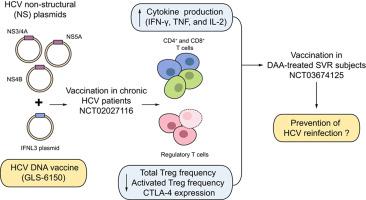当前位置:
X-MOL 学术
›
J. Hepatol.
›
论文详情
Our official English website, www.x-mol.net, welcomes your
feedback! (Note: you will need to create a separate account there.)
IFNL3-adjuvanted HCV DNA vaccine reduces regulatory T cell frequency and increases virus-specific T cell responses
Journal of Hepatology ( IF 26.8 ) Pub Date : 2020-02-21 , DOI: 10.1016/j.jhep.2020.02.009 Ji Won Han 1 , Pil Soo Sung 2 , Seon-Hui Hong 3 , Hoyoung Lee 3 , June Young Koh 1 , Hyojin Lee 4 , Scott White 5 , Joel N Maslow 4 , David B Weiner 6 , Su-Hyung Park 7 , Moonsup Jeong 4 , Jeong Heo 8 , Sang Hoon Ahn 9 , Eui-Cheol Shin 7
Journal of Hepatology ( IF 26.8 ) Pub Date : 2020-02-21 , DOI: 10.1016/j.jhep.2020.02.009 Ji Won Han 1 , Pil Soo Sung 2 , Seon-Hui Hong 3 , Hoyoung Lee 3 , June Young Koh 1 , Hyojin Lee 4 , Scott White 5 , Joel N Maslow 4 , David B Weiner 6 , Su-Hyung Park 7 , Moonsup Jeong 4 , Jeong Heo 8 , Sang Hoon Ahn 9 , Eui-Cheol Shin 7
Affiliation

|
Although direct-acting antiviral (DAA) treatment results in a sustained virologic response (SVR) in most patients with chronic HCV infection, they are at risk of re-infection. Moreover, the immune system is not completely normalized even after SVR ( increased regulatory T [Treg] cell frequency). We developed a DNA vaccine, GLS-6150, to prevent re-infection of patients with DAA-induced SVR and evaluated its safety and immunogenicity in individuals with chronic HCV infection. GLS-6150 consists of plasmids encoding HCV non-structural proteins (NS3-NS5A) and adjuvant The vaccine was administered 4 times at 4-weekly intervals to 3 groups (1, 3, or 6 mg/vaccination; n = 6 per group), followed by a 6 mg boost at 24 weeks (n = 14). Peripheral blood T cell responses were evaluated by interferon (IFN)-γ enzyme-linked immunospot assays, intracellular cytokine staining, and major histocompatibility complex class-I (MHC-I) dextramer staining. Treg cell frequency was assessed by flow cytometry. Severe adverse events or vaccine discontinuation were not reported. The IFN-γ spot-forming cells specific to NS3-NS5A were increased by GLS-6150. Both CD4 and CD8 T cells produced multiple cytokines. However, the frequency and phenotype of HCV-specific MHC-I dextramerCD8 T cells were not changed. Interestingly, the frequency of Treg cells, particularly activated Treg cells, was decreased by GLS-6150, as expected from previous reports that adjuvants decrease Treg cell frequency. IFN-λ3 treatment reduced Treg frequency in pre-vaccination peripheral blood mononuclear cells. Finally, Treg cell frequency inversely correlated with HCV-specific, IFN-γ-producing T cell responses in the study participants. We demonstrate that GLS-6150 decreases Treg cell frequency and enhances HCV-specific T cell responses without significant side effects. A phase I clinical trial of GLS-6150 is currently underway in patients with DAA-induced SVR. . Although direct-acting antivirals (DAAs) are successfully used for the treatment of chronic hepatitis C virus (HCV) infection, a prophylactic HCV vaccine needs to be developed, especially for patients who achieve a sustained virologic response. In the current study, we show that a DNA vaccine (GLS-6150) was safe and increased HCV-specific T cell responses. A clinical trial is underway to test this vaccine in patients with a sustained virologic response following DAA therapy.
中文翻译:

IFNL3 佐剂 HCV DNA 疫苗可降低调节性 T 细胞频率并增加病毒特异性 T 细胞反应
尽管直接作用抗病毒 (DAA) 治疗可使大多数慢性 HCV 感染患者产生持续病毒学应答 (SVR),但他们仍面临再次感染的风险。此外,即使在 SVR(调节性 T [Treg] 细胞频率增加)之后,免疫系统也没有完全正常化。我们开发了一种 DNA 疫苗 GLS-6150,用于预防 DAA 诱导的 SVR 患者的再次感染,并评估了其在慢性 HCV 感染个体中的安全性和免疫原性。 GLS-6150 由编码 HCV 非结构蛋白 (NS3-NS5A) 的质粒和佐剂组成。疫苗以 4 周为间隔,分 3 组接种 4 次(1、3 或 6 mg/疫苗;每组 n = 6) ,然后在 24 周时加强 6 mg (n = 14)。通过干扰素 (IFN)-γ 酶联免疫斑点测定、细胞内细胞因子染色和主要组织相容性复合物 I 类 (MHC-I) 右聚体染色评估外周血 T 细胞反应。通过流式细胞术评估Treg细胞频率。没有报告严重不良事件或疫苗停用。 GLS-6150 增加了 NS3-NS5A 特异性的 IFN-γ 斑点形成细胞。 CD4 和 CD8 T 细胞均产生多种细胞因子。然而,HCV特异性MHC-I右旋CD8 T细胞的频率和表型没有改变。有趣的是,GLS-6150 降低了 Treg 细胞,特别是活化的 Treg 细胞的频率,正如之前佐剂降低 Treg 细胞频率的报道所预期的那样。 IFN-λ3 治疗降低了疫苗接种前外周血单核细胞中 Treg 的频率。最后,研究参与者中 Treg 细胞频率与 HCV 特异性、产生 IFN-γ 的 T 细胞反应呈负相关。 我们证明 GLS-6150 降低了 Treg 细胞频率并增强了 HCV 特异性 T 细胞反应,且没有明显的副作用。 GLS-6150 的 I 期临床试验目前正在 DAA 诱导的 SVR 患者中进行。 。尽管直接作用抗病毒药物 (DAA) 已成功用于治疗慢性丙型肝炎病毒 (HCV) 感染,但仍需要开发预防性 HCV 疫苗,特别是对于获得持续病毒学应答的患者。在当前的研究中,我们证明 DNA 疫苗 (GLS-6150) 是安全的,并且可以增强 HCV 特异性 T 细胞反应。一项临床试验正在进行中,以在 DAA 治疗后出现持续病毒学反应的患者中测试这种疫苗。
更新日期:2020-02-21
中文翻译:

IFNL3 佐剂 HCV DNA 疫苗可降低调节性 T 细胞频率并增加病毒特异性 T 细胞反应
尽管直接作用抗病毒 (DAA) 治疗可使大多数慢性 HCV 感染患者产生持续病毒学应答 (SVR),但他们仍面临再次感染的风险。此外,即使在 SVR(调节性 T [Treg] 细胞频率增加)之后,免疫系统也没有完全正常化。我们开发了一种 DNA 疫苗 GLS-6150,用于预防 DAA 诱导的 SVR 患者的再次感染,并评估了其在慢性 HCV 感染个体中的安全性和免疫原性。 GLS-6150 由编码 HCV 非结构蛋白 (NS3-NS5A) 的质粒和佐剂组成。疫苗以 4 周为间隔,分 3 组接种 4 次(1、3 或 6 mg/疫苗;每组 n = 6) ,然后在 24 周时加强 6 mg (n = 14)。通过干扰素 (IFN)-γ 酶联免疫斑点测定、细胞内细胞因子染色和主要组织相容性复合物 I 类 (MHC-I) 右聚体染色评估外周血 T 细胞反应。通过流式细胞术评估Treg细胞频率。没有报告严重不良事件或疫苗停用。 GLS-6150 增加了 NS3-NS5A 特异性的 IFN-γ 斑点形成细胞。 CD4 和 CD8 T 细胞均产生多种细胞因子。然而,HCV特异性MHC-I右旋CD8 T细胞的频率和表型没有改变。有趣的是,GLS-6150 降低了 Treg 细胞,特别是活化的 Treg 细胞的频率,正如之前佐剂降低 Treg 细胞频率的报道所预期的那样。 IFN-λ3 治疗降低了疫苗接种前外周血单核细胞中 Treg 的频率。最后,研究参与者中 Treg 细胞频率与 HCV 特异性、产生 IFN-γ 的 T 细胞反应呈负相关。 我们证明 GLS-6150 降低了 Treg 细胞频率并增强了 HCV 特异性 T 细胞反应,且没有明显的副作用。 GLS-6150 的 I 期临床试验目前正在 DAA 诱导的 SVR 患者中进行。 。尽管直接作用抗病毒药物 (DAA) 已成功用于治疗慢性丙型肝炎病毒 (HCV) 感染,但仍需要开发预防性 HCV 疫苗,特别是对于获得持续病毒学应答的患者。在当前的研究中,我们证明 DNA 疫苗 (GLS-6150) 是安全的,并且可以增强 HCV 特异性 T 细胞反应。一项临床试验正在进行中,以在 DAA 治疗后出现持续病毒学反应的患者中测试这种疫苗。











































 京公网安备 11010802027423号
京公网安备 11010802027423号